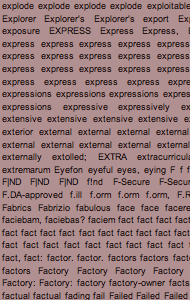|
|
Date: 2006
Project Type: Software


Exercise for Paivi Hintsanen's
Uninvited Words
Description
For Uninvited Words, the artist alphabetically filed and organized all of the uninvited spam (see glossary) words that came to him via email during November 2004. His project makes the spam public material and for viewing and play. Unlike a painting or a sculpture, Uninvited Words does not have one final form. Instead, it exists as multiple objects: viewers can download pieces of text to create his or her own spam installation; text files of the spam words can be downloaded; and audio of a computer voice reading spam can be streamed. Users can also generate art from their own spam.
Purpose
This exercise helps students transform found objects, or even unwanted material, into art.
Exercise
Warm-Up Activity (10 min): The educator should give examples of artworks that use found materials. Suggested examples (in glossary) include Marcel Duchamp, Robert Rauschenberg, and the Heidelberg Project by Tyree Gunton. The educator should explain how found materials in art blur boundaries between the world of art and the real world or daily life. By recontextualizing found objects as art, artists can change the objects' meanings. Play (20 min):The educator should explain the term spam and the Uninvited Words project. Students should play Uninvited Words and test out all the different possibilities for interacting with spam.
Follow-Up Discussion (5 min): The educator should lead students in a follow-up discussion. Suggested questions could include:
- Do students understand what spam is? Do any of them receive spam? Is there anything in their lives that they can compare to spam?
- Do they like Uninvited Words? Why or why not?
- What is the connection between Uninvited Words and the artists discussed in the Warm-Up Exercise?
Activity (15 min): Students should take 5 minutes to scour the classroom, their lockers, or desks for found material. Then, working individually, they should write down answers to the following questions:
- Describe this object or collection of objects.
- What is its significance to you?
- How did you get it?
- Does the object bring you happiness or irritation?
- How could you bring out this meaning of the object in an art piece to change its meaning?
Students should then present their object to the class.
|






